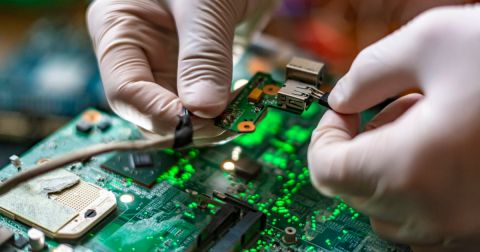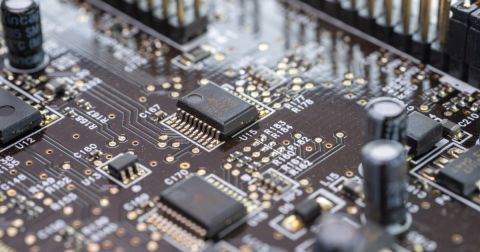AI Chip Export Bans: Potential Effects and Key Concerns

It is fair to say that some major changes are taking place since President Donald Trump’s inauguration on 19 January, 2025, namely a reversal of Former President Joe Biden’s executive order on the risks of artificial intelligence (AI).
There is no doubt that AI plays a major role in commercial development and will continue to do so as technology becomes a staple in the country’s most profitable industries. The distribution of AI-related products has become a hot topic, especially with trade tariffs rising for electronic components and the products in which they are used.
Now, the future is uncertain. It is difficult to know whether proper measures will be taken to manage the movement of AI goods, particularly in the US, where the Biden Administration had already begun implementing a proactive framework for safe and consistent exports.
Nevertheless, the new government is likely to rethink the 2023 framework and its strategy for AI consumption and exports, especially since it came under so much scrutiny from industries at the time. Why are so many opposed to the AI chip export ban, and what would happen if it materialized?
The Significance of AI Chips in Modern Society
There are two sides to the argument around AI chips and their function in society. The "for" debate is driven by economic demand. AI has proven its worth in countless applications globally, aiding private businesses and public services like healthcare and security.
AI chips, specialized processors designed to handle AI workloads, are foundational to technological advancements. Their significance stems from the growing need for intelligent solutions in both sectors, requiring advanced chips for greater computational power.
As AI integrates further into society, slowing its development—such as through export bans—could have far-reaching effects. However, better governance is essential as AI adoption expands with minimal regulation until recently.

Export Controls Are Tightening
Export controls are tightening as tensions between China and the US evolve. These two global powers dominate the PCB and semiconductor sectors, and trade tariff increases, along with tighter restrictions, are prominent issues. While a Democratic government may have tempered some previous policies, geopolitical competition remains a key driver.
The close trade relationship between China and the US significantly impacts the sector, shaping the future of AI and component availability. Whether disputes persist or global AI access is prioritized, ripple effects may redirect chip supplies and reduce supply chain options.
Just six days before President Biden left office, the US Government announced further restrictions on AI chip exports. These measures aim to control the potential use of AI chips in military applications that could threaten national defense. At the same time, such restrictions reflect competitive strategies as countries strive to localize the production of critical technologies.
This trend toward localization has expanded beyond semiconductors to include emerging technologies like climate tech, electric vehicles (EVs), and aerospace and defense electronics. By reducing reliance on foreign supply chains, governments aim to cut costs and secure strategic autonomy in the rapidly advancing tech landscape.

What Caused an AI Chip Export Ban?
National Security Concerns
AI chips are critical for military and defense applications, serving as key components in autonomous weaponry, surveillance systems, and advanced cybersecurity. The US government has expressed fears that adversaries like China could use American-made AI chips to enhance their own military capabilities, posing a direct threat to national security.
Restricting exports of powerful semiconductors for AI use is a means of controlling the global flow of high-performance technologies and ensuring they are not leveraged by other nations to undermine strategic interests.
Economic Protectionism
Export controls serve to protect US dominance and localize semiconductor use. The US is home to leading chip design and advanced manufacturing, and restrictions aim to prevent the erosion of its leadership in this space.
Additionally, the US is highly conscious of intellectual property theft, which costs the country USD $600 billion annually. Economic protectionism also benefits domestic producers, allowing US chipmakers a greater share of the market.
Political Leadership
This is where the main shift will occur in 2025, as regulations introduced by the previous government are reconsidered. While economic and security concerns have driven these changes, the new administration must carefully navigate both industry needs and geopolitical realities. The Semiconductor Industry Association (SIA) has already expressed concerns to the current leadership, urging clarity on the future of chip exports.

Impact of a Ban on AI Chip Exporters
There are inherent risks associated with using substandard semiconductors, but any export ban must also consider the broader impact of restricting access to high-performance chips.
Both private and public sector organizations may feel the consequences of a chip ban, particularly regarding cybersecurity, national health, and security. From smart infrastructure to defense, these impacts would be felt by parts suppliers, manufacturers, consumer goods producers, and retailers.
Private Sector
- Shrink the Market: Particularly for technology companies, a ban on AI chip exports would reduce international market access, cutting off some of the major revenue streams for new and established businesses. Tightening restrictions on AI chip imports would impact countries in the EU and Southeast Asia, which depend on US-made products.
- Disrupt Supply Chains: Similarly, the ripple effect of this ban would be a major disruption to supply chain revenues. Whether companies can afford such restrictions to their customer base will be a point of contention between the US government and the business community.
- Slow Innovation: NVIDIA’s high-capacity chips are essential to advancing AI applications across consumer tech, industrial systems, and data centers. Export restrictions, where applied, can influence global access to these technologies and potentially slow the pace of innovation in affected markets.
Public Sector
- Slow Innovation in Defense: Limiting the development of technology in the defense sector can be just as detrimental to national security as the implementation itself. This is well known by countries adopting AI in their forces, and requires a high level of due diligence to determine the best course of action—with or without a ban. The same goes for the US government, as reduced export of AI chips will likely see a similar response from other countries, so will have to ensure that its internally are fit for the job.
- Restrict Research and Development: This will impact economic growth but also healthcare as the industry takes a major stake in the use of AI for rapid medical research. For example, DeepMind’s AlphaFold 2 was seen to be instrumental in the development of knowledge around COVID-19, and will only develop further to provide more predictive capabilities in protein identification.
- Curb Transportation Developments: While smart transportation is still in its infancy—based on the prospects for future connected infrastructure—its growth could be fast-paced with the implementation of AI.
The current presidential term, coupled with evolving AI technologies, brings uncertainty as international tensions grow. The semiconductor industry is eager to discuss its future under new leadership, calling for careful consideration of both security and innovation to ensure progress in the rapidly advancing tech landscape.
As countries like China and the US strive for self-sufficiency, they must also balance the impacts of AI on public health, transport, defense, and the private sector to ensure that such drastic measures align with their interests.
Stay Proactive Amid Geopolitical Shifts with Octopart
As the conversation around AI chip exports continues to evolve, staying informed and proactive is more important than ever.
Octopart is uniquely positioned to help businesses navigate this volatile landscape with confidence. With always up-to-date access to pricing and availability from hundreds of authorized distributors and manufacturers, users can quickly evaluate sourcing options without jumping across platforms.
Octopart’s inventory history lets users track 12 months of stock fluctuations to better understand supply patterns, while stock alerts provide timely email notifications when part availability changes, helping teams act before shortages impact production.
During the pandemic, Octopart proved to be a critical tool for engineers and buyers facing unprecedented supply chain disruptions. When parts weren’t available through traditional channels, Octopart helped users discover alternative sources, proving its value when resilience mattered most. That same capability continues today, making Octopart a trusted source of truth in a rapidly shifting global supply chain.








